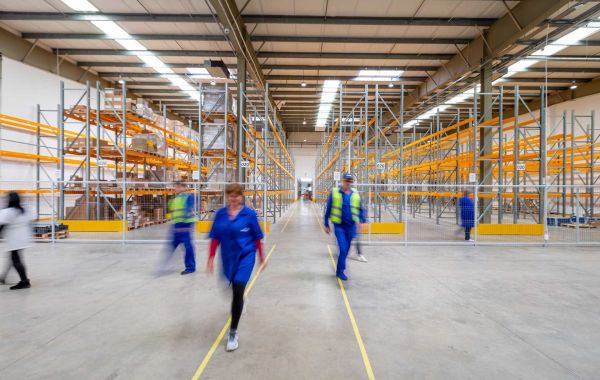Warehouse automation is becoming increasingly popular in the world of supply chain and logistics. Companies are turning to automated technologies to reduce costs, streamline operations, and improve safety and efficiency. With so many types of warehouse automation technology available, it can be difficult to know which one is best for your business.
In today's world, automation technology is revolutionizing the way warehouses operate. Automation technology can help increase efficiency, reduce costs, and improve the quality of your warehouse operations. Whether you are a small business owner or a large corporation, understanding the different types of warehouse automation technology available is essential for staying ahead of the competition.
In this blog post, we will discuss the various types of warehouse automation technology you need to know. We will explore the advantages and disadvantages of each type of technology, as well as provide tips for selecting the right automation system for your warehouse.
Here are The Types of Warehouse Automation Technology:
Warehouses are becoming increasingly automated to keep up with the needs of modern industry and the expectations of consumers. There is a variety of warehouse automation technology available to help warehouses increase efficiency, reduce costs, and improve accuracy. Here are some of the most common types of warehouse automation technology:
These are just some of the types of warehouse automation technology available. Each system has its own benefits and drawbacks, so it’s important to evaluate which system best meets your needs before investing in any technology.
Pick-to-Light Systems
This type of automation offers several advantages over manual picking, including improved accuracy and efficiency. With pick-to-light systems, workers no longer have to rely on paper or other visual cues to determine where to pick items from the warehouse. Instead, they are presented with a series of lit panels that tell them exactly what item to pick, how many to pick, and where it needs to be shipped. This eliminates errors and saves time by eliminating the need for multiple trips back and forth across the warehouse.
Voice Picking Systems
The voice-picking technology offers flexibility as the operators can easily move around the warehouse to pick items while following instructions. Additionally, this technology provides accuracy as it reduces errors by having the operator double-check their orders and confirm the picked items before packing them. Voice-picking technology also increases speed of order fulfillment, as it helps reduce time spent manually writing down orders or double checking barcodes.
Overall, voice picking systems provide a safe and efficient solution for order picking and can be tailored to individual company needs. This automation technology can help save costs, streamline operations, and increase productivity in warehouses.
Radio-Frequency Identification (RFID)
RFID tags are placed on products, pallets, or even the floor of the warehouse. When the RFID reader detects these tags, it will send the product's information to the system's computer, which can then be used to track the product as it moves through the warehouse. RFID can also be used to check inventory levels, as well as ensure accuracy in orders.
One advantage of using RFID is that it eliminates manual scanning, which often leads to errors and increases operational costs. Additionally, RFID eliminates the need for barcodes, meaning that products don’t have to be labeled and re-labeled.
RFID is a great solution for warehouses looking to increase their efficiency, reduce manual labor, and improve accuracy. However, it is important to note that this type of warehouse automation technology requires an upfront investment in order to set up properly.
Automated Storage and Retrieval Systems (AS/RS)
AS/RS are computer-controlled systems used to store and retrieve items in warehouses. AS/RS technology eliminates the need for manual labor, allowing operations to become more efficient, accurate and cost-effective. AS/RS utilize a variety of systems, including conveyors, carousels, automated guided vehicles, and robots.
These automated systems are typically composed of a storage area, an input/output station, and an inventory management system. Storage areas can vary in size, but they often consist of several levels that can be quickly accessed by an automated system. The input/output station is where products are loaded and unloaded, while the inventory management system keeps track of the products being stored.
Automatic Guided Vehicles (AGVs)
The operation of an AGV is quite simple. The vehicle is equipped with various sensors that allow it to detect obstacles and navigate its path accordingly. This ensures that the AGV can safely navigate its way around the warehouse without any human assistance. Additionally, AGVs can be customized with a variety of attachments, such as lifts and gripping devices, so they can easily carry items of different sizes and shapes.
AGVs are highly efficient and effective in warehouses, especially when they are integrated with other warehouse automation technologies, such as radio-frequency identification (RFID) tags and conveyor systems. By using AGVs, businesses can minimize their labor costs while increasing the speed and accuracy of their operations. This makes them an ideal solution for warehouses looking to streamline their processes and improve their bottom line.
Conveyor Systems
Conveyors are available in a variety of shapes and sizes, depending on the size and scope of the warehouse in which they will be used. Belt conveyors, roller conveyors, skate wheel conveyors, vertical conveyors, and spiral conveyors are some of the more common types of conveyors found in warehouses.
Overall, conveyor systems are an incredibly efficient way to move products throughout a warehouse. They can improve safety, reduce costs, and improve efficiency, making them an essential part of any warehouse automation system.
Conclusion
Warehouse automation technology is a critical component of successful warehouse management. Automated systems offer greater accuracy and efficiency than manual processes, enabling you to reduce costs, improve customer service and increase profitability. From pick-to-light systems to automatic guided vehicles, there are many different types of automation technology available to help businesses meet their goals.
Additionally, integrating warehouse management software into the automation process can further increase efficiency and accuracy while providing businesses with comprehensive visibility into their operations. By investing in warehouse automation technology, businesses can ensure that their warehouses are running at peak efficiency and are able to maximize their profits.
Read Also:
How to Build an On-Demand Fuel Delivery App for Your Business
The Top 10 AR Furniture Shopping Apps That Will Change The Way You Do Business








